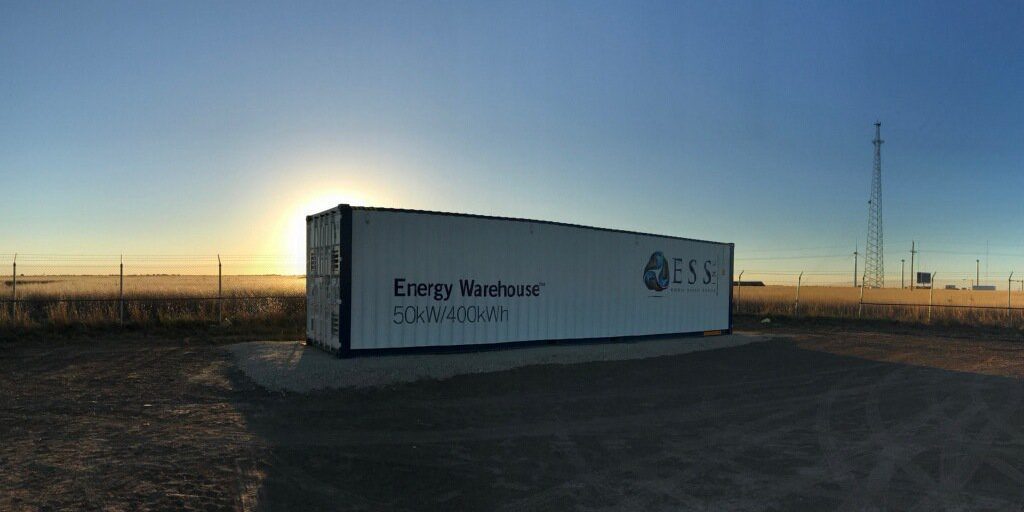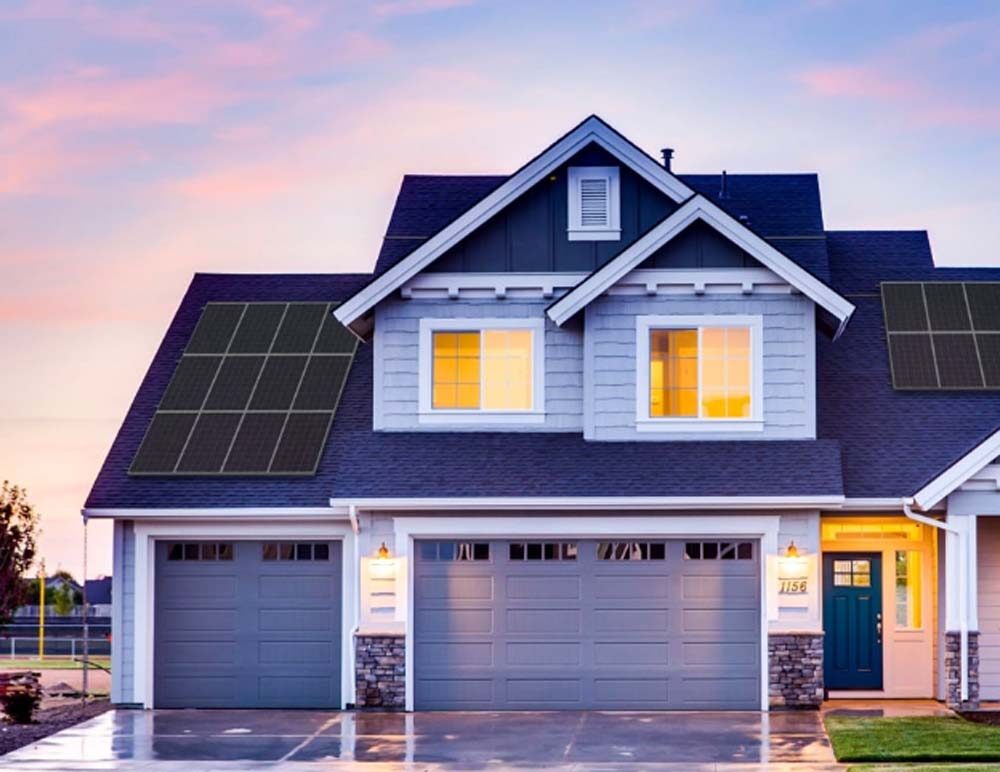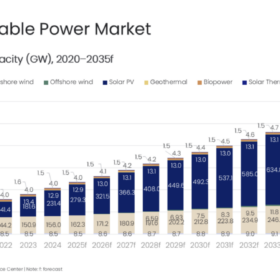Ten teams working to drive down the cost of long duration storage are competing in a way, using federal grant support to make enough progress to earn a follow-on grant for pilot-scale production. Projects include a sulfur flow battery for full-week backup capability, and a more efficient means of converting electricity to hydrogen and back again.
Each project aims toward a goal of 5 cents/kWh for storage that can last for days, under the DAYS program of the U.S. Department of Energy’s Advanced Research Projects Agency (ARPA-E).
Here are highlights of the ten projects, spanning corporate, university and hybrid teams.
Sulfur flow batteries
Flow batteries use electricity to produce an electrolyte, which may be stored separately from the battery. The electrolyte is later “flowed” through the battery to generate electricity. As a result, long-duration storage using flow batteries requires only a large storage capacity for electrolyte.
Form Energy aims to achieve “full-week backup capability” with a sulfur flow battery “at a factor of 10 or greater cheaper” than lithium-ion batteries, said company co-founder Marco Ferrara in a video posted by global utility Enel. Form Energy may ultimately pilot its battery technology in a joint project with Enel.
“Aqueous sulfur flow batteries represent the lowest chemical cost among rechargeable batteries,” says Form Energy’s grant award notice, but have low efficiency. To improve efficiency, the firm is working on anode and cathode formulations, membranes and physical system designs.
A United Technologies project is focused on sulfur and manganese flow batteries, and has three project partners: Lawrence Berkeley National Laboratory, MIT, and Pennsylvania State University. The project aims to “overcome challenges of system control and unwanted crossover of active materials through the membrane.”
Electricity to hydrogen
A team at the University of Tennessee, Knoxville aims to improve the efficiency of the round-trip process of converting electricity to hydrogen and back again. The current process uses electricity to power an electrolyzer to convert water to hydrogen and oxygen, and then uses the hydrogen and oxygen in a fuel cell to produce electricity and water.
“It has long been a goal to make a regenerative fuel cell, a single device that functions as both a fuel cell and an electrolyzer,” said lead researcher Dr. Thomas Zawodzinski, as quoted in a university press release. “However, such devices have previously suffered from poor overall efficiency. The new project uses an alternative approach by changing one of the chemical reactions in the cell and bypassing the efficiency bottleneck.”
The Tennessee team will develop a system in which a reversible fuel cell converts hydrogen and oxygen to liquid hydrogen peroxide instead of water. Later, electricity will be used to power the same reversible fuel cell, now operating as an electrolyzer, to convert the hydrogen peroxide to hydrogen and oxygen—which are also stored, ready to begin the cycle again. “The benefit of using peroxide instead of water is higher efficiency in both charging and discharging the system,” says the ARPA-E award notice.
The research comes as global investment in “green” hydrogen—which is produced using solar or wind power—is accelerating.
Zinc-bromine flow batteries
Primus Power already makes zinc bromide flow batteries, and has been awarded a $4 million grant from the California Energy Commission to increase manufacturing capacity of its 25 kW, 5-hour EnergyPod 2.
Under its ARPA-E grant, Primus Power will work with the Columbia Electrochemical Energy Center to “eliminate the need for a separator to keep the reactants apart when charged,” by “taking advantage of the way zinc and bromine behave in the cell.” The new configuration is expected to allow all the electrolyte to be stored in a single tank, instead of multiple cells, thus reducing balance-of-plant hardware, and system costs.
Thermovoltaics
Antora Energy will use electricity to power resistive heaters, to heat carbon blocks to over 2000°C. To generate electricity, the carbon blocks will be exposed to thermovoltaic panels. With its ARPA-E grant, Antora will develop a “thermovoltaic heat engine,” seeking to double panel efficiency through new materials and “smart system design.”
Electricity to magnesium manganese
A team at Michigan State University will develop a modular system that heats magnesium manganese oxide (Mg-Mn-O) particles to a high enough temperature that the particles release oxygen. To generate electricity, the system will pass air over the particles (now Mg-Mn), initiating a chemical reaction that releases heat to drive a gas turbine generator.
Electricity to heat
Three projects aim to increase the efficiency of storing electricity as heat, and then using the heat to drive a turbine-generator set.
The National Renewable Energy Laboratory will develop a system that uses electricity to power a high-performance heat exchanger, which will heat inexpensive solid particles to over 1100°C. The particles will be stored in insulated silos for up to several days. When electricity is desired, the hot particles will be fed through a fluidized bed heat exchanger, heating a working fluid to drive a Brayton combined-cycle turbine attached to a generator. The Colorado School of Mines is a project partner.
Brayton Energy will “develop a key component” to enable a cost-competitive thermal energy storage system with innovative turbomachinery. The innovation will relate to Brayton’s “reversing, counter-rotating turbine design, in which each turbomachinery stage is designed to act as both a compressor and turbine, alternating between charging and discharging cycles.” The approach is expected to both increase efficiency and reduce capital costs, by simplifying the system.
Echogen will use electricity to heat a low-cost material such as sand or concrete. Later, to generate electricity, the heat would be used to heat liquid carbon dioxide—previously brought to a supercritical pressure—and the heated, supercritical carbon dioxide would expand through a turbine to generate electricity.
Pressurizing water underground
Quidnet Energy is developing a process to pump water into “confined rock underground, creating high pressures.” Under its ARPA-E grant, Quidnet will demonstrate the ability to generate electricity from water stored at pressure underground, and find suitable means to make the process work across multiple types of geography within the U.S.
Next steps
Five of the projects will be completed in 2021, and the other five in 2022. Each project team must estimate costs for a full-scale system, which will be evaluated in comparison to ARPA-E’s 5 cents/kWh goal for long-duration storage.
ARPA-E envisions a second phase of the program, to fund construction of one or more prototype systems that are placed in field use.
The Department of Energy is also supporting research and development of lower-cost photovoltaics, in a complementary initiative.
This content is protected by copyright and may not be reused. If you want to cooperate with us and would like to reuse some of our content, please contact: editors@pv-magazine.com.








We’ll see. Anything under 60% efficient electric input total round trip, is unlikely to be viable killing half of them.
I’ve never seen the value of a complicated flow battery vs using the same materials to make a more solid one.
Storing heat from solar, etc directly is cool but from electricity is woefully inefficient.
Zinc bromide is a mass casualty event waiting to happen. Just say no.
More likely are metal/air and LiS . These can be made now and stockpiled for a yr or more if recharging was switched to
reforming.
And up to 8kwh/kg, enough for ships, planes if swapped with reformed cells turning metal into an oxide.
And even lead using submarine type cells and a cell reformer, unlimited life as something will need to be done with all the lead li-ion replaces. Luckily it makes good 20 yr life industrial battery.
Li-ion though is cheap and getting cheaper is going to be hard for any competitor to beat as it drops to $50/kwh cell price in 5 yrs.
And all these will compete with home, EV packs which will be the majority of future storage in 15 yrs or less.
Highview Power’s liquid-air energy storage (LAES) technology seems to be a better solution.
“proven in the field at a 5MW/15MWh grid-connected pilot project near Manchester — is able to store huge amounts of power for months at a time in any location, and at a far cheaper price than any other energy-storage system.”
“For a 100MW system, we are already touching [a levelized cost of storage (LCOS) of] $100 per MWh today,” chief executive Javier Cavada tells Recharge. “In ten years from now, I can see that being $50/MWh. That’s very doable.
By comparison, a new pumped-hydro plant would have an LCOS of $152-198 per MWh, with a comparable lithium-ion system costing $285-581/MWh, according to analyst Lazard.
With a new gas-peaker plant having a levelized cost of energy of $156-210/MWh, and wind power at $30-60/MWh (according to Lazard), it may already cheaper to balance the grid using wind-powered liquid-air storage than fossil-fuel technology. And if the LAES system is “charged” using wind power that would otherwise be curtailed, the wholesale price of that power would be close to zero.”
https://www.rechargenews.com/transition/liquid-air-storage-offers-cheapest-route-to-24-hour-wind-and-solar/2-1-635666
Yeah, I looked at the Highview website and ‘another’ article is saying a ‘cryobattery’ of 200MW/2GWh would be $140/MWh LCOS. IF one looks at LAZAR (4.0) the cost of this storage is somewhere in the cost of the storage systems LAZAR did vet. I’d like to see just how LAZAR would treat (LAES) and in which grid service storage use would be the ‘proper’ use for this technology.
The best large energy storage for energy plants is LARGE local hydrogen production factories with hydrogen fuel cell modules in adjacent areas. Hydrogen can be stored as compressed hydrogen gas instead of liquid hydrogen, especially at the first stage of the hydrogen economy.
An interesting collection of ideas. There must be a hundred different technologies competing to be the future kings of storage. To many people it would be interesting to know how many applicants there were initially and what they were. Maybe a one line statement of why they were rejected.
This overall contest between the hundred (or so) current contenders and another herd of unknown contenders is a very important for the future. The basis for a decision seems to be who has the cost advantage at some unknown moment in the future. How do we ensure that the world adopts the best technology? We (as a society) don’t want the winner to be the technology that can afford the best “influencers” Remember VHS vs Beta that absorbed a fortune in research and development funding and was won by the second best system that only lasted for a few years before the next technology came along and wiped out all that value. A very inefficient way for mankind to progress.
It seems that for lcoe it would be more practical to install 300% production assets in wind and solar, shunting the rest to intermittent (opportunity users) production like aluminum and desalination or even cement production. In addition, during repermitting, stipulate fast response retrofitting and open up over 800 unpowered dams in the Army Corps of Engineers portfolio to co-op hydro development. These are low hanging fruit an more economically pursuable for roi of public funds.